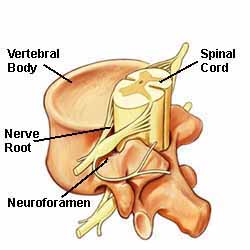Spinal Nerve Injuries
Compressive Neuropathy (ner-awe-path ee) occurs when nerves are compressed. The effects may be temporary or may permanently destroy nerves

Nerve compression may result when a disc slips, herniates, ruptures, or bulges. Nerves may become compressed or even displaced with the growth of bone spurs.
A compressive neuropathy may cause pain to radiate (ray-dee-ate) into the buttock (one or both), down the leg(s) as far as the knee(s), and can even be felt in the ankle(s) and foot (feet). Sensations of tingling, numb ness, and weakness might accompany pain.
Sciatica (sy-attic-ka) is an example of a com pressive neuropathy. Sciatica is a relatively common ailment named after the Sciatic Nerve.
The sciatic nerve is a collection of smaller nerves descending from the spine and joining together to re semble a cable. This nerve travels down through each buttock into the legs.
At certain points, such as in the posterior thighs, nerves branch off from the main sciatic cable. This is why sciatic pain may be felt in one or both thighs.
A direct blow to the sciatic nerve, which could occur during a fall, may result in injury to this nerve. The result from a sudden fall might initiate bleeding around the nerve(s) causing nerve compression and pain. Even coughing and sneezing could be consid ered as compression generators because these actions create pressure and may temporarily intensify pain
When a disc or bone spur protrudes into the sciatic nerve cable, the problem may become severe. Even a bone spur could displace the sciatic nerve cre ating pain. Fortunately, there are conservative nonsur gical treatments that may be used to reduce the inflam mation and associated pain, such as steroid injections and medication.
If the above interventions fail, and depending on the patient's symptomatology, surgery may be consid ered a treatment option. In some cases, a laminotomy (lamb-in-ott-toe-me) may be performed, which gives the surgeon greater access to the offending intervertebral disc.
Peripheral Neuropathy (per-if-fur-all ner awe-path-ee) is another type of nerve disorder. This is a degenerative condition affecting the nerves branch ing into the body's extremities such as the arms, hands, legs, and feet. The disease causes the peripheral or distant parts of nerves to shrink
Eventually the nerves in the affected area may deteriorate. When the nerves can no longer carry im pulses, sensory (feeling) and/or motor (movement) function(s) may be lost
The patient may experience burning sensations, a feeling of pins and needles, an inability to feel the tips of the fingers or toes, and a weakness in grip and/or during walking.
The physician may be able to slow the effects of peripheral neuropathy with medication, but cannot cure or stop its progression.
Spinal Infections are rare and painful. Immediate medical attention is always warranted. If an infection is not detected and treated, the effected area swells and pain radiates into adjoining tissue. It may result in permanent injury.
A spinal infection may take root in the epidural (ep-eye-dur-all) cavity. This is a fatty area near a nerve and is a cozy home for an infection or abscess. These fatty areas are found in the cervical, thoracic, and lum bar spine. An MRI is usually performed to confirm the diagnosis.
Conservative treatment consists of intravenous or oral antibiotics combined with bed rest. If this ap proach is unsuccessful, then surgical interventions may be used to eradicate the infection and remove any af fected spinal elements.
Spinal Meningitis (men-in-gi-tis) is a type of infection that causes inflammation of membranes in the brain and/or spinal cord. This is a serious disease that may require hospitalization. The patient is usually treated with intravenous or oral antibiotics combined with bed rest
Some of the symptoms may include fever, weak ness, pain radiating from the spine, muscle spasm, sensitivity to touch, decreased spinal flexibility, fatigue, sweating, and weight loss. When a child is affected, symptoms might include his or her refusal to stand or sit due to the pain. Increased backache may be a sig nal in older children and adults
